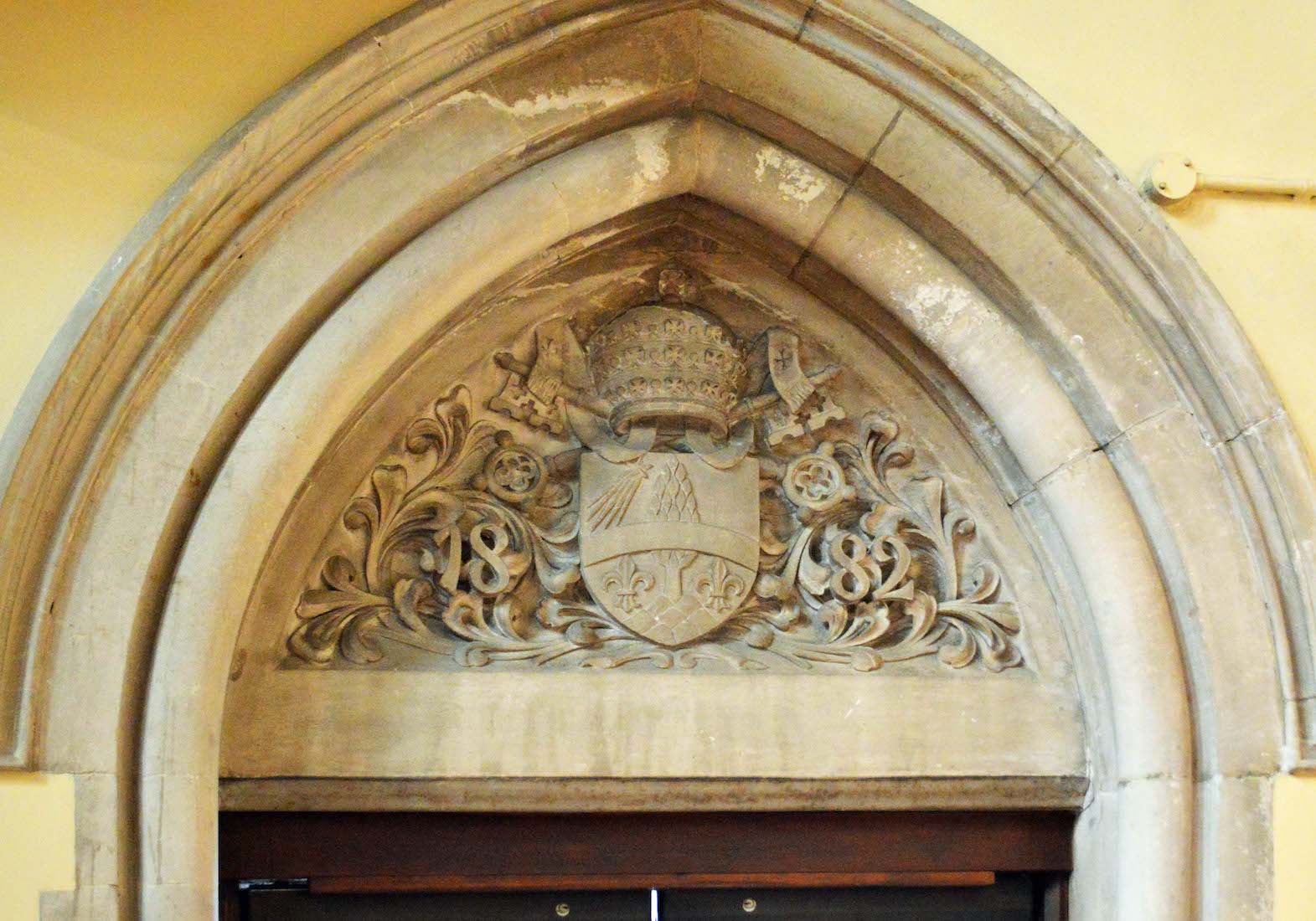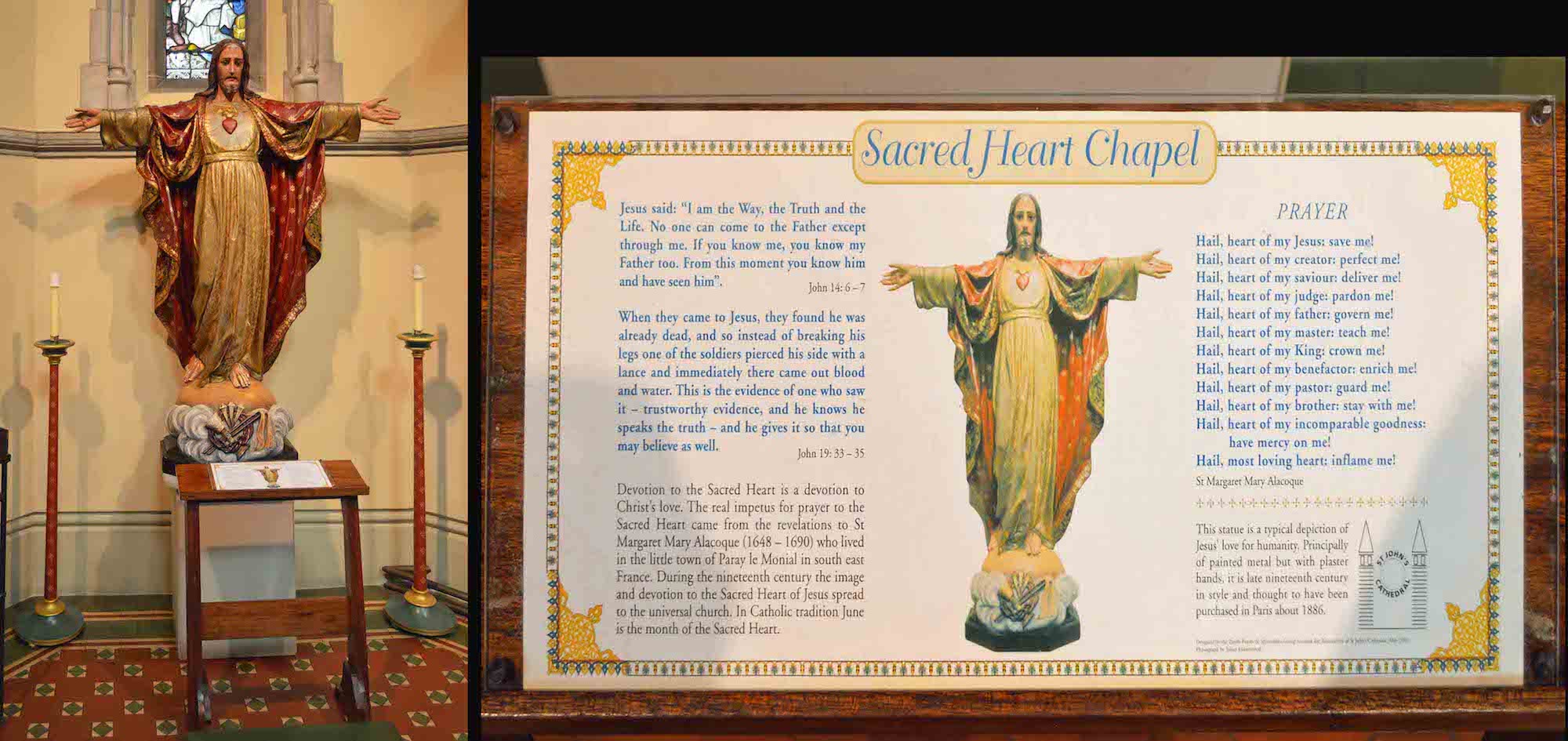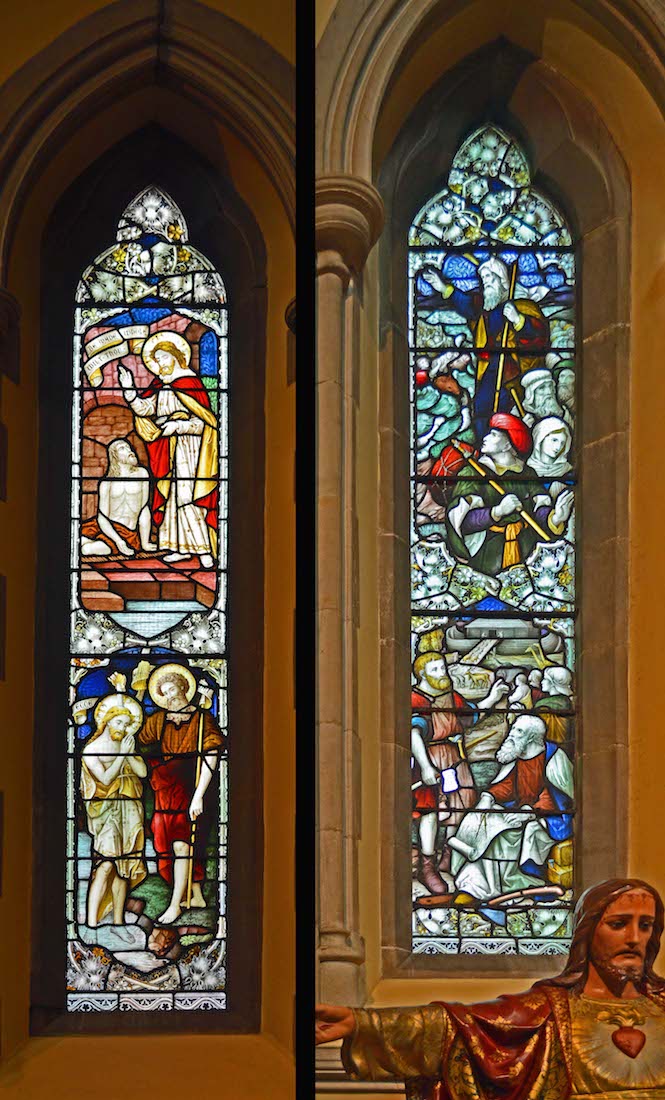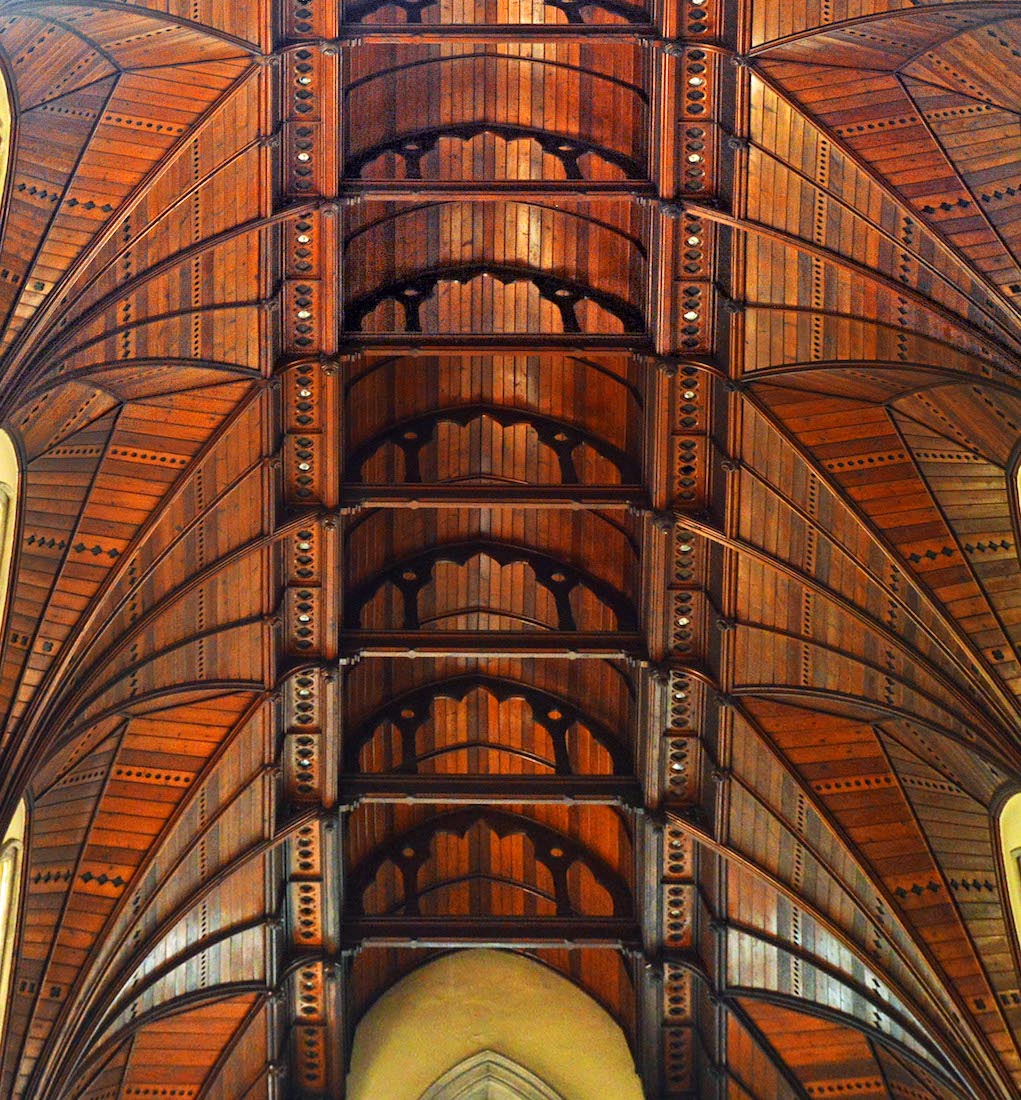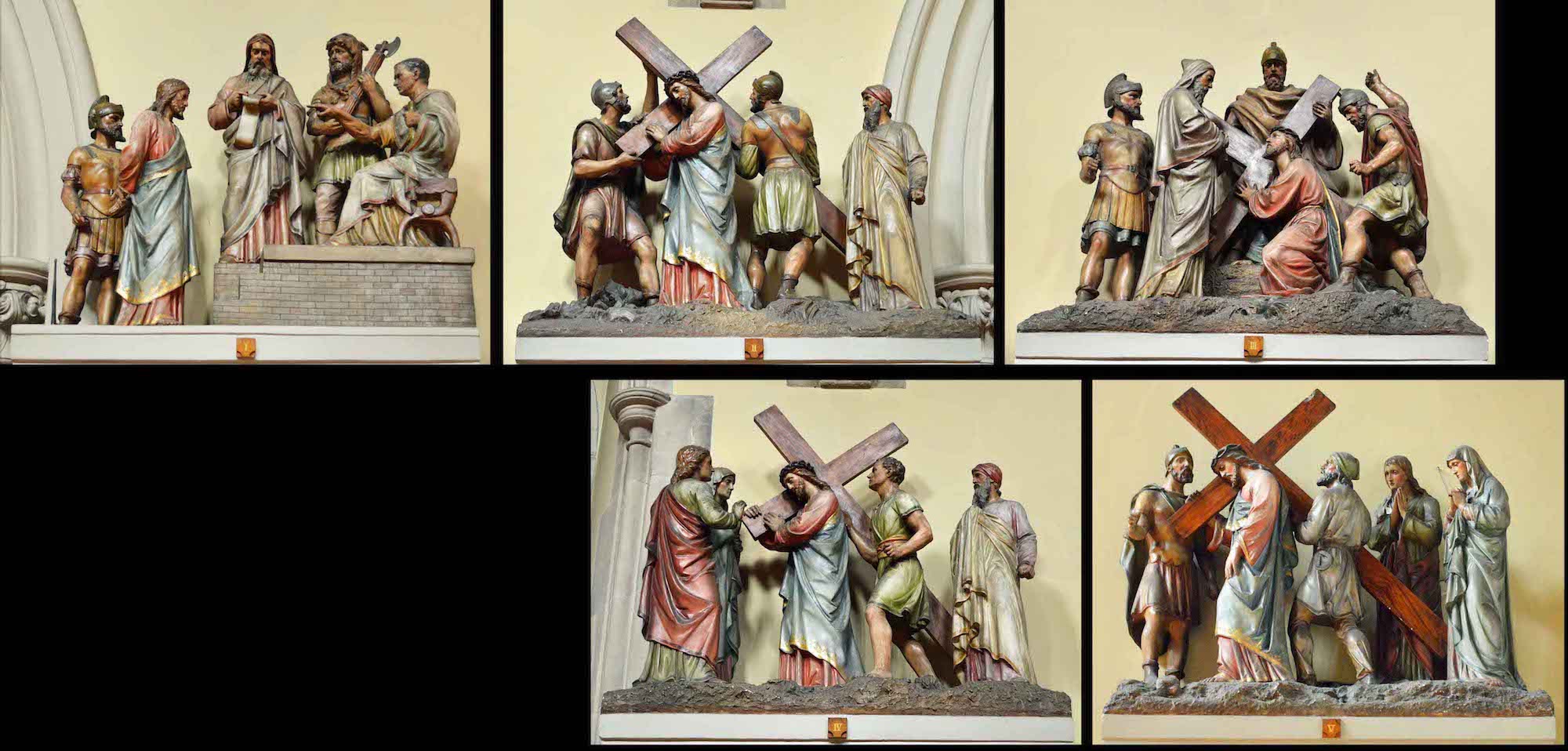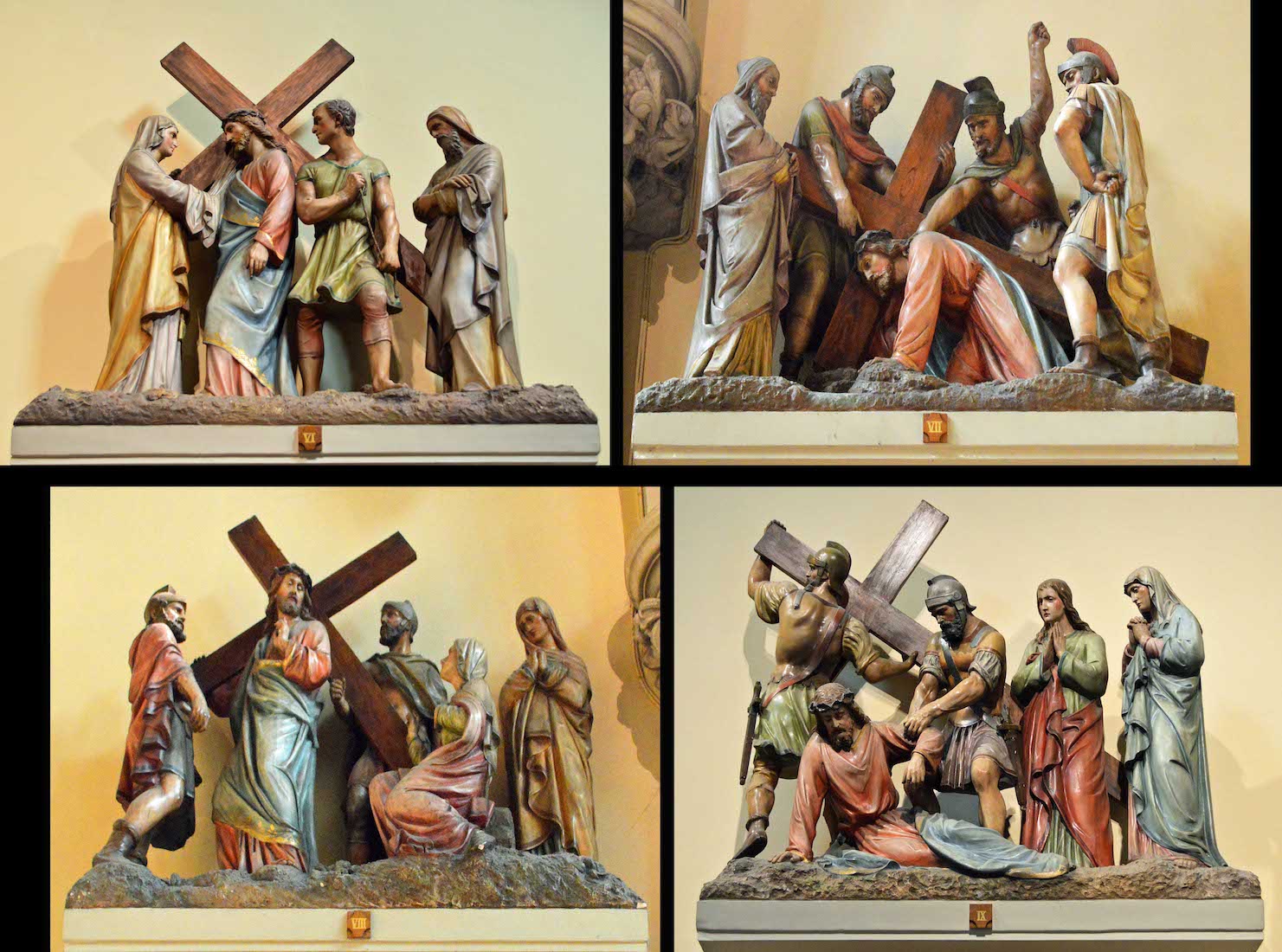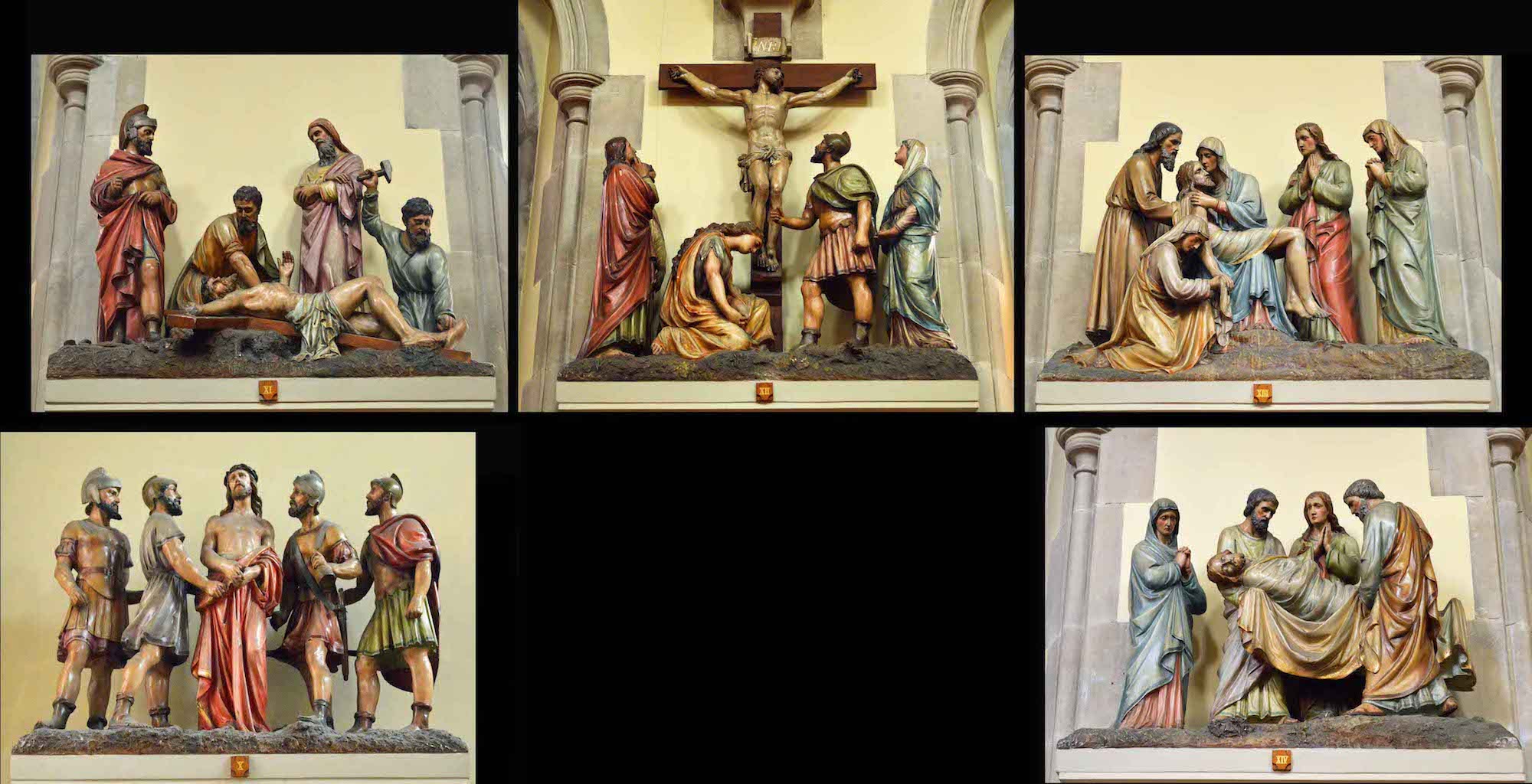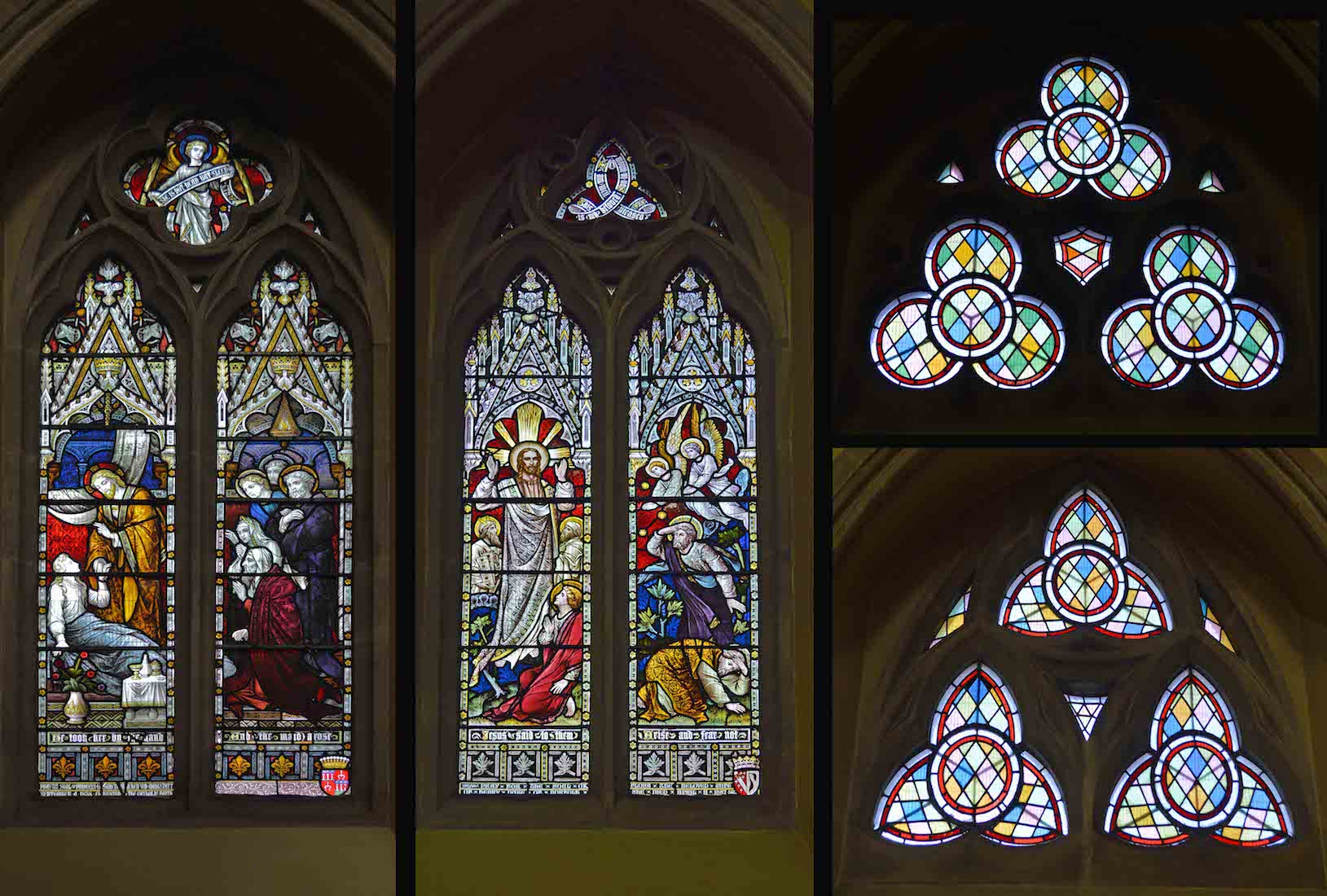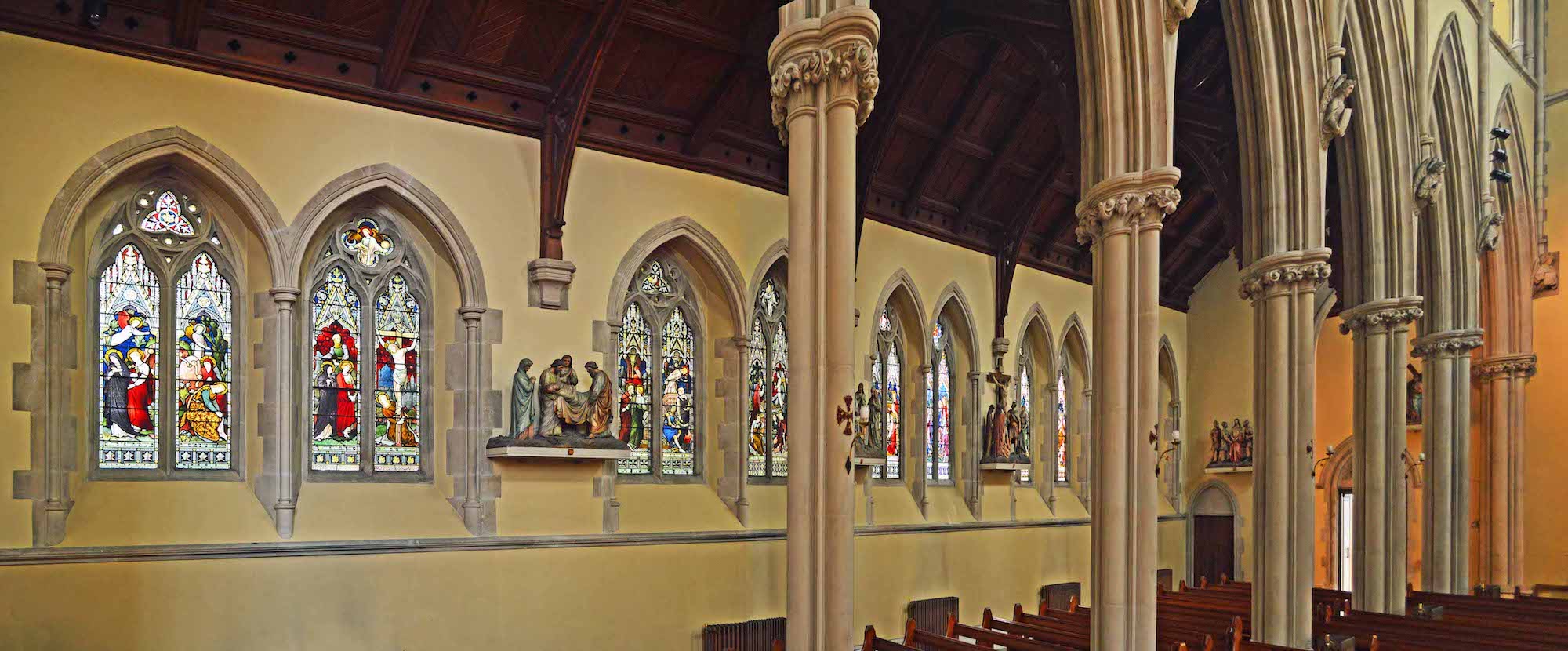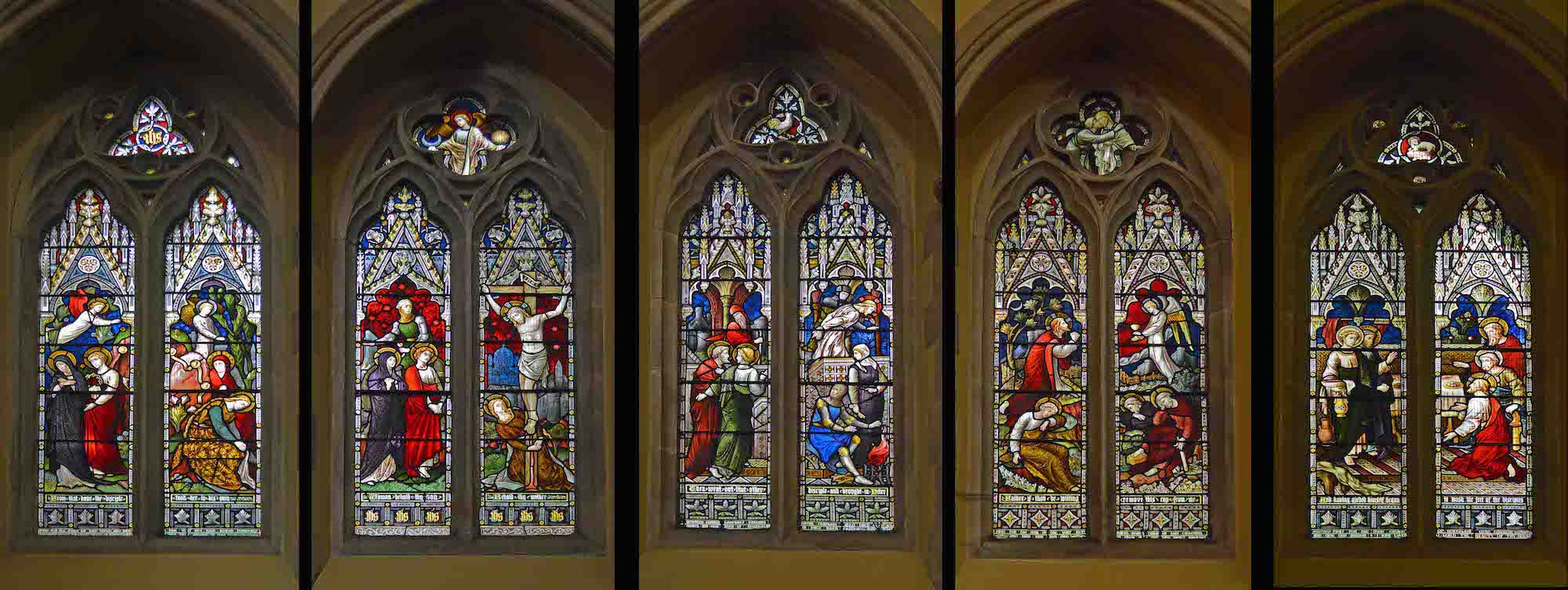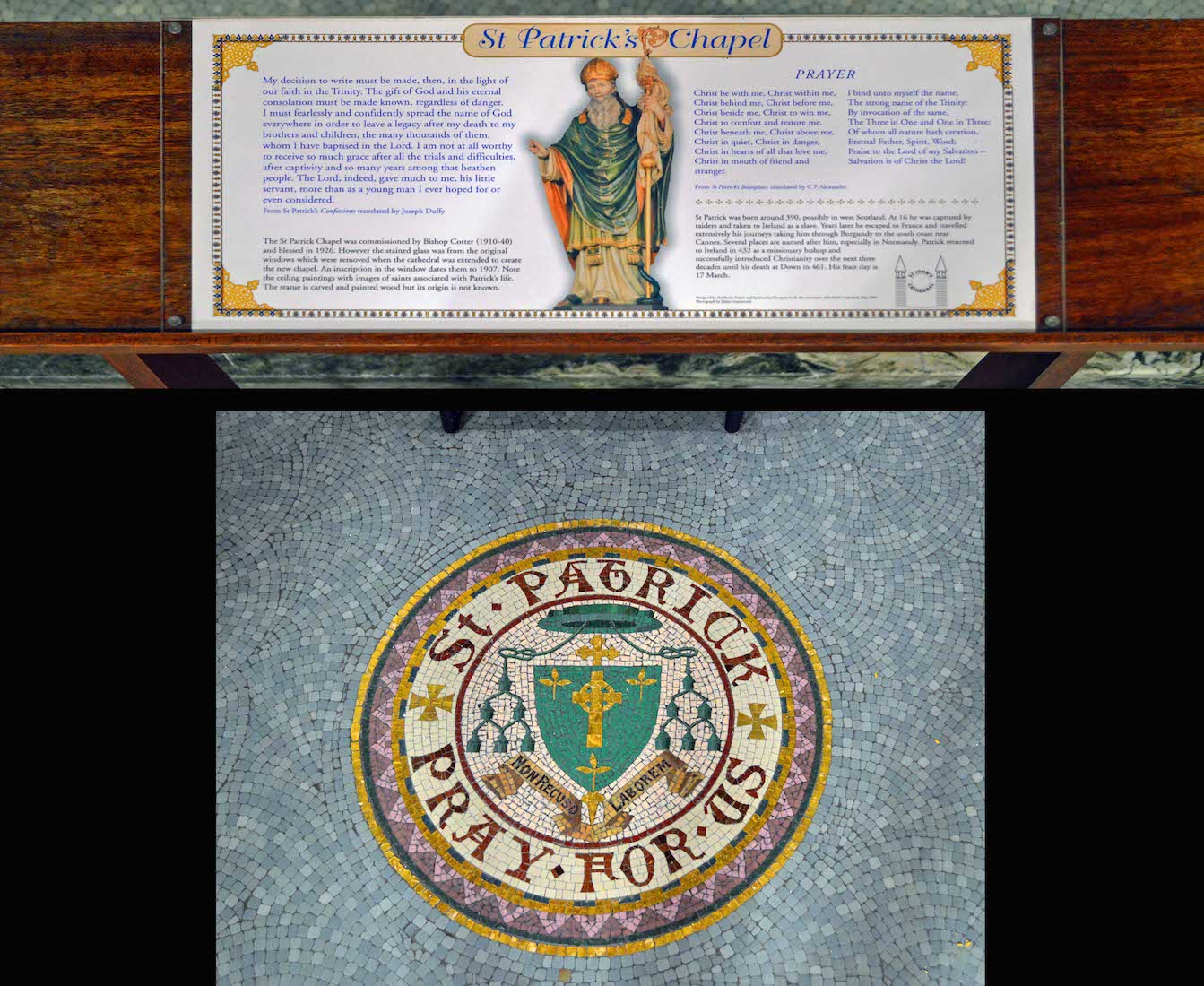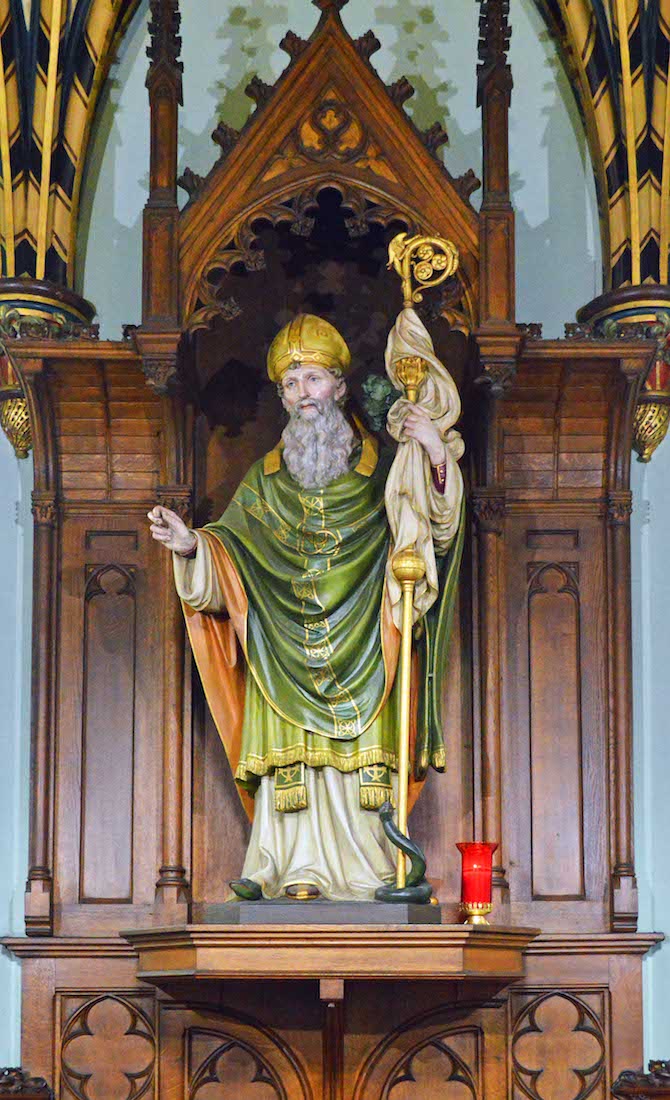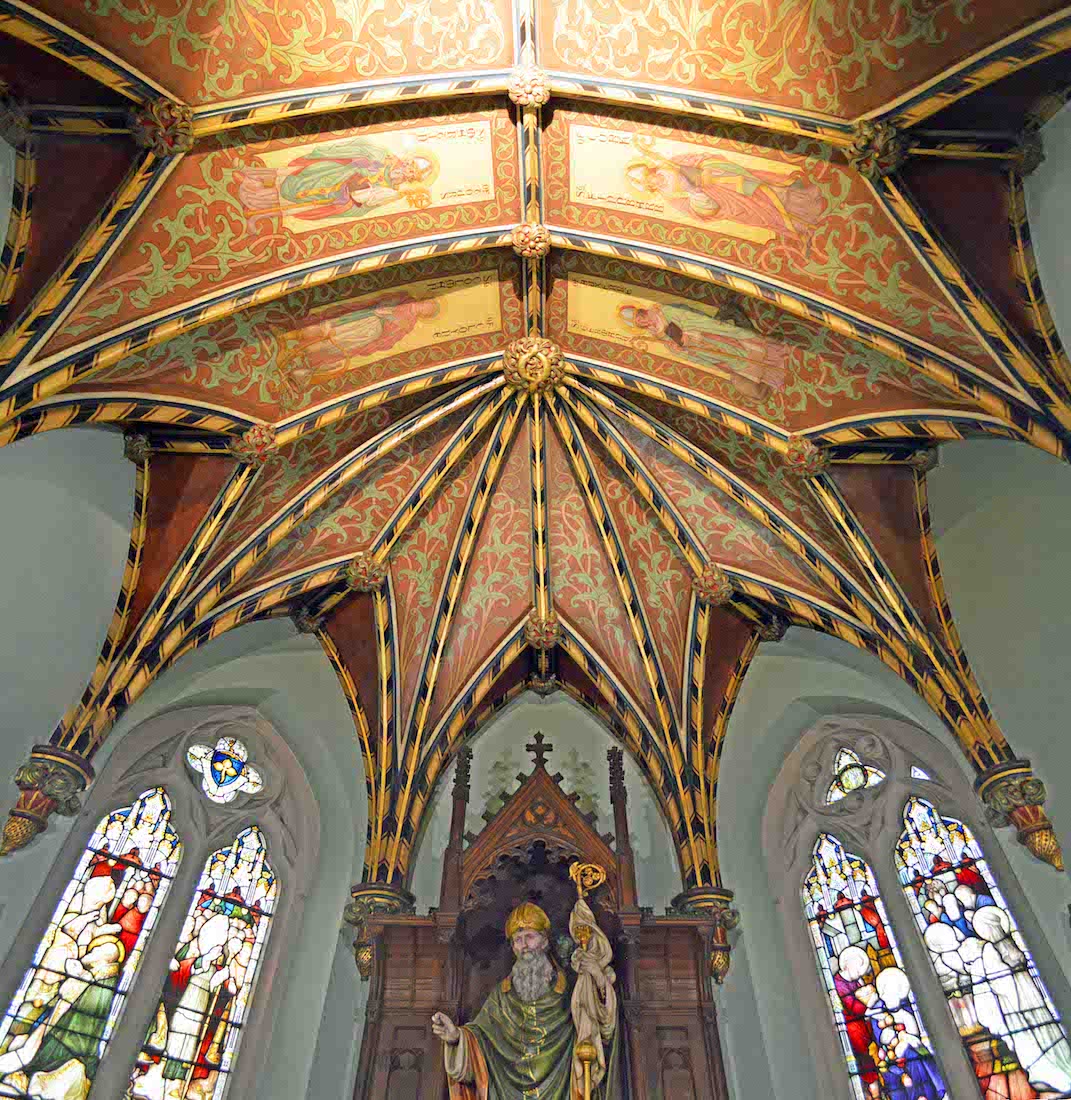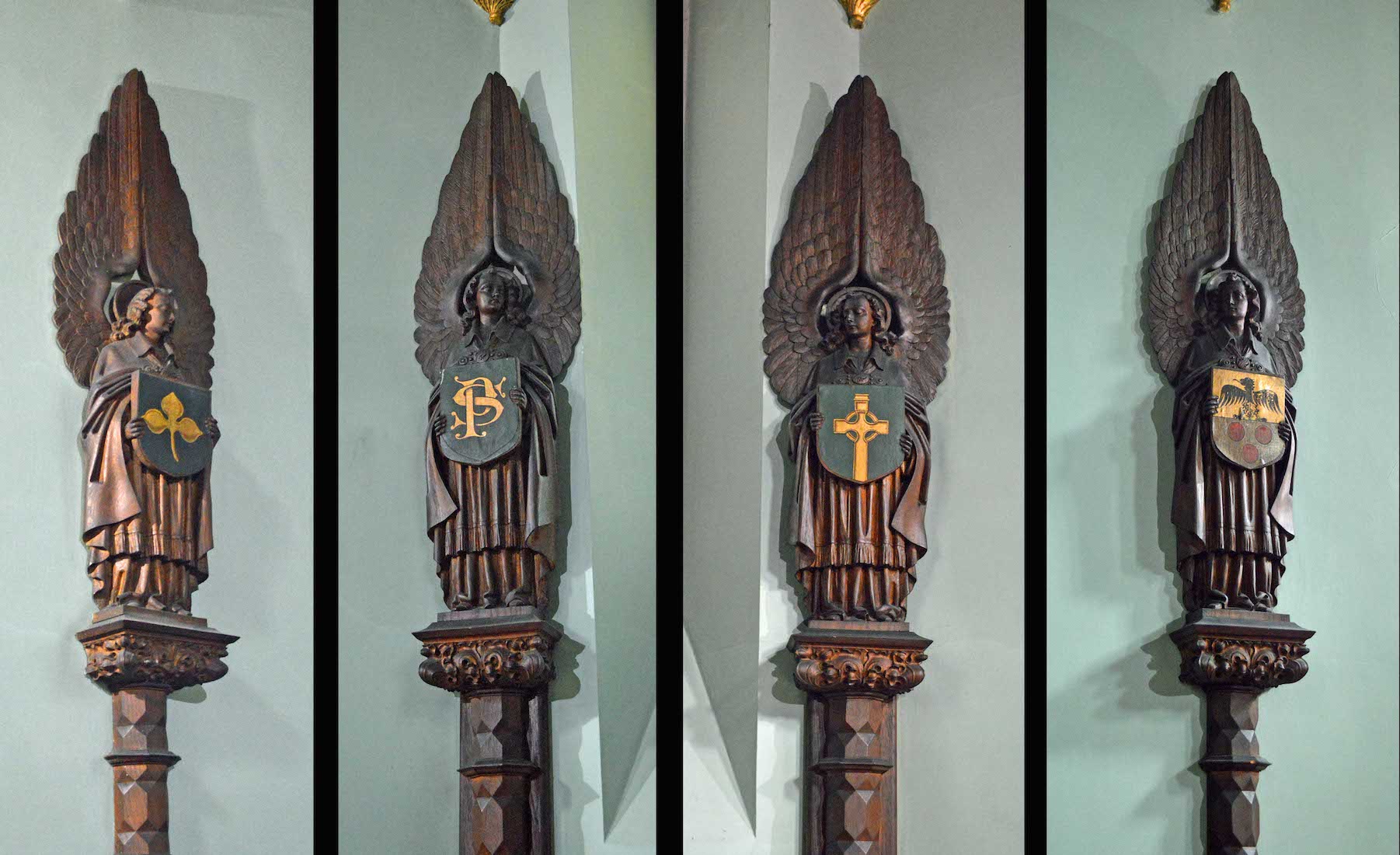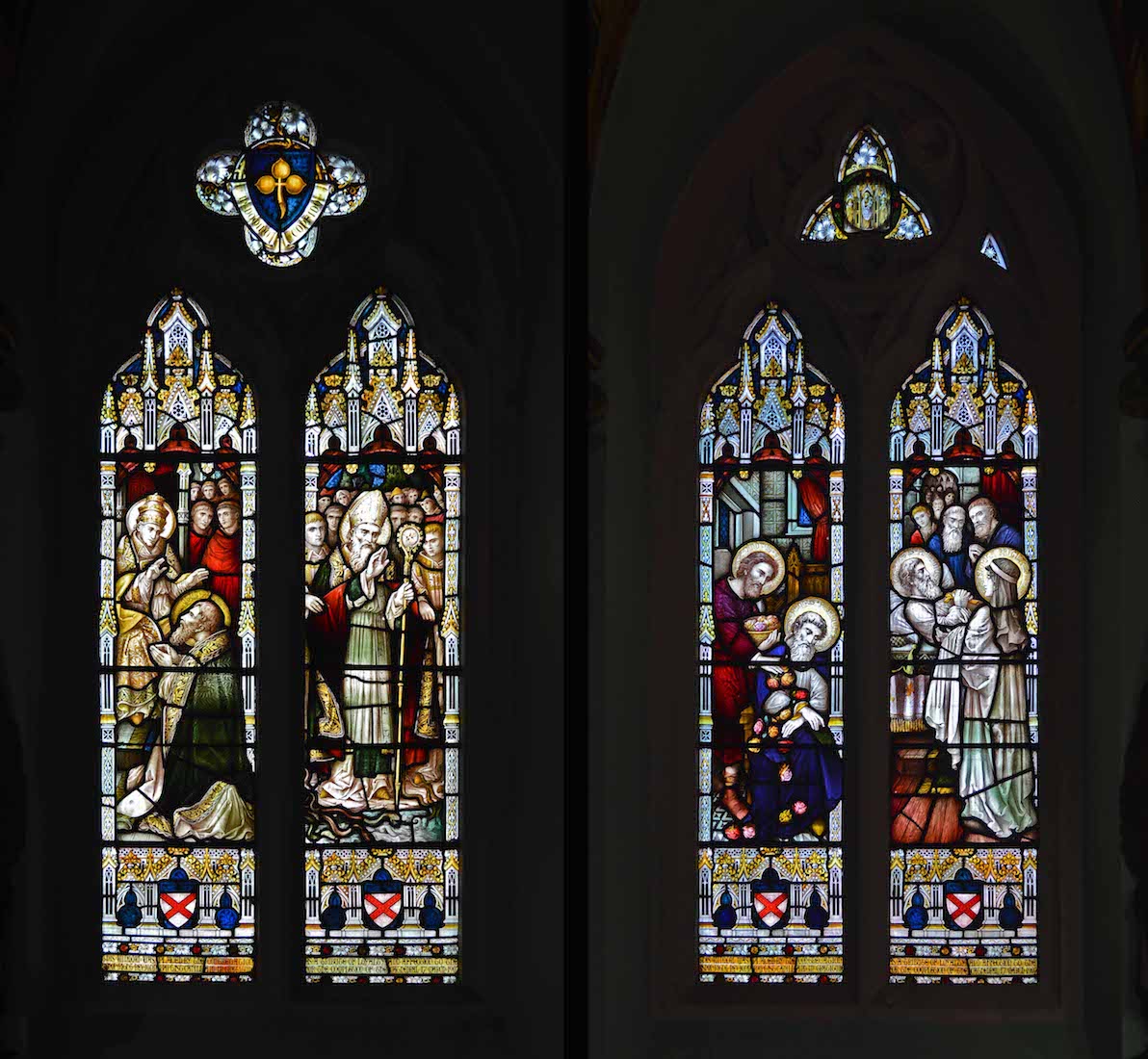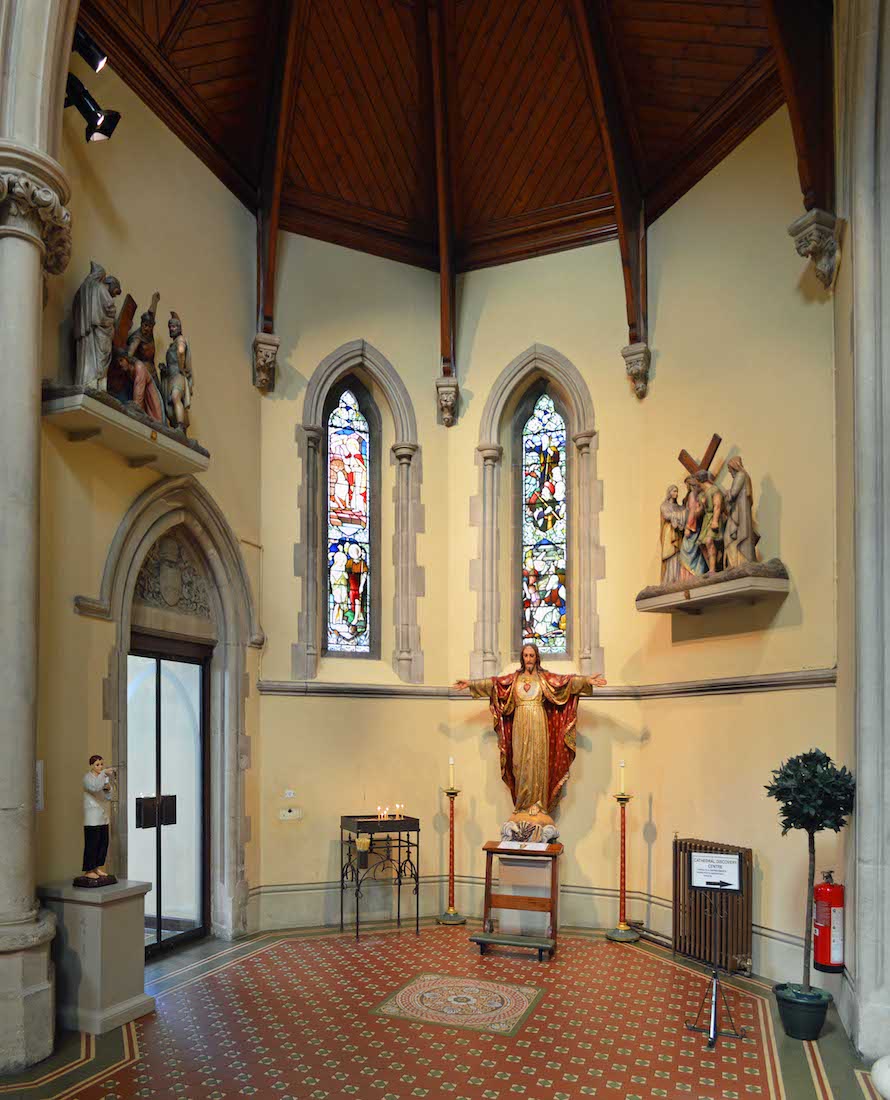
We now look across to the Northwest tower room – the Chapel of the Sacred Heart. This has the same components as the last chapel: a statue (the Sacred Heart) between two candlesticks, but with a candle stand as well; two stained glass windows, and two Stations of the Cross. We note a further small statue at extreme left. There is also a tympanum over the door. A similar mosaic square decorates the floor in front of the Christ figure. PLAN
22. ST LORENZO RUIZ
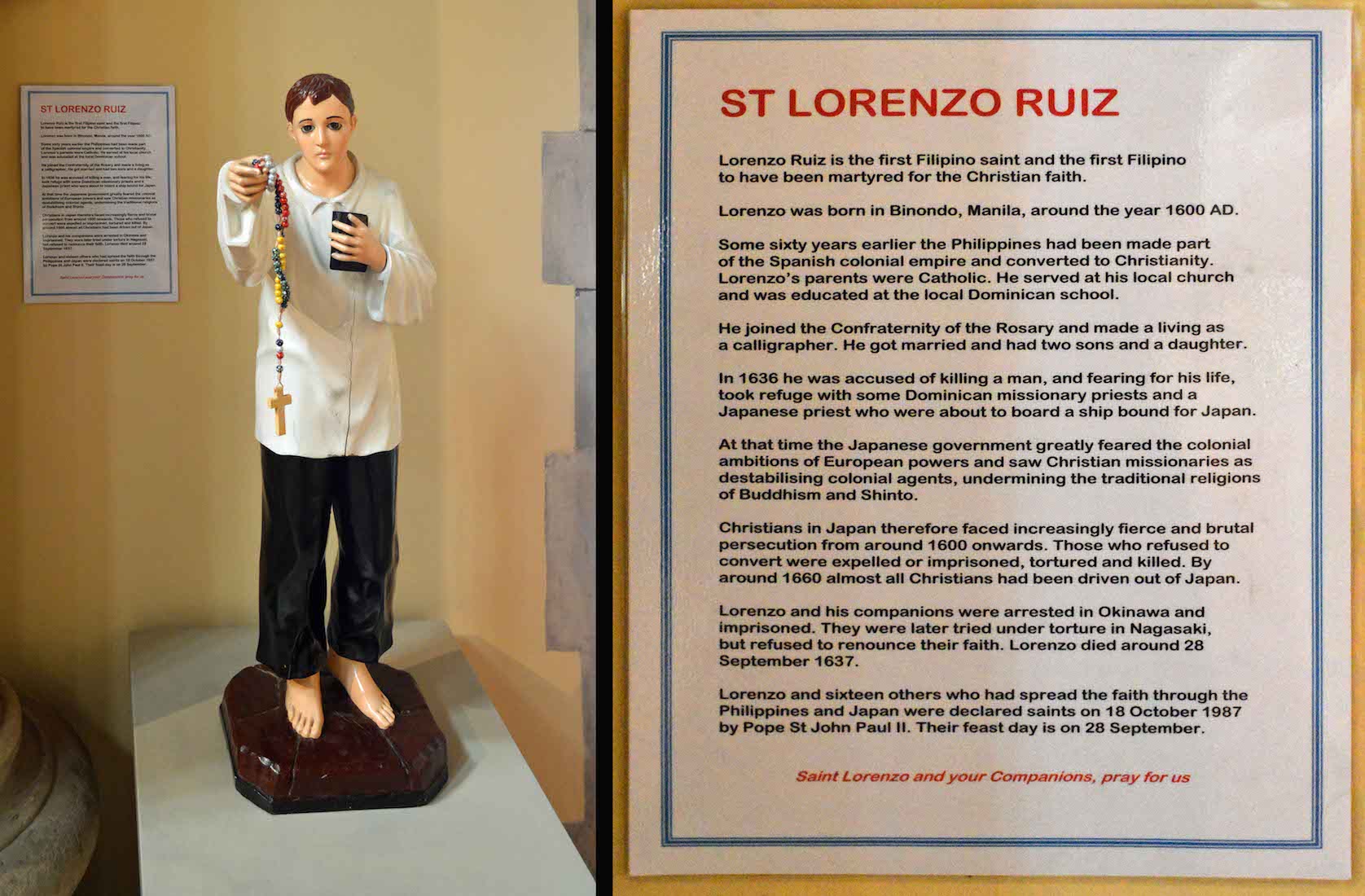
The small statue is of St Lorenzo Ruiz (1600 – 1637). He is the first Filipino saint, and the first Filipino to have been martyred for the Christian faith. In 1636 he was accused of killing a man and fled to Japan with some Dominican missionaries. There he refused to renounce his faith, and was tortured and put to death.
23. NORTHWEST TYMPANUM
This tympanun shows the coat of arms of Pope Leo XIII. We note the crossed keys, the mitre-crown, the single star shedding its light, the pine tree and the two fleurs de lys. The date 1882 refers to the completion of the Cathedral building, and the conferring of the Cathedral title by Pope Leo XIII in that year.
24. SACRED HEART
The main figure in this chapel is that of Jesus, the Sacred Heart. On the desk in front is an information sheet. The devotion to the Sacred Heart is one of the most widely practised and well-known Roman Catholic devotions, taking Jesus Christ’s physical heart as the representation of his divine love for humanity. This devotion is predominantly used in the Roman Catholic Church and among some high-church Anglicans and Lutherans.
25. SACRED HEART CHAPEL WINDOWS
Here we have windows with New Testament and Old Testament themes. At left are scenes of Jesus healing rhe lame man by the Pool of Bethesda, and below the baptism of Jesus by John. In the window at right are two salvation pictures: Moses leading the Israelites across the Red Sea, and below, a depiction of Noah and the ark.
26. NAVE
Leaving the chapels we return to the West end of the nave aisle to admire the nave stretched out before us. The architecture is Midland High Gothic. Above are stained timbers of the ceiling. Graceful, slender columns march down towards the sanctuary, connected by Gothic arches. Notice the angel between each adjacent pair of arches. The side walls are lined with stained glass windows and elegant Stations of the Cross. [Photograph credit: Wikimedia, David Iliff]
27. NAVE ROOF
The nave roof is very attractive, with timber vaulting reaching up from the Gothic arches, and meeting in a lengthwise semicircular cylinder (barrel) at the roof apex. The Cathedral lighting is incorporated along the joins. We might recall that the word ‘nave’ is connected to the upturned hull of a boat – seen here with a little imagination, and a particularly appropriate image for the City of Portsmouth.
28. STATIONS OF THE CROSS I – V
We now investigate the memorable Stations of the Cross. As we have seen, these were given in memory of the second bishop, John Cahill. They are amazingly realistic three-dimensional portrayals of stages along the Way of the Cross. Here we have pictured: I Pilate condemns Jesus to die; II Jesus accepts his cross; III Jesus falls for the first time; IV Jesus meets his mother, Mary; V Simon helps carry the cross.
29. STATIONS OF THE CROSS VI – IX
The stations grew out of imitations of Via Dolorosa in Jerusalem which is believed to be the actual path Jesus walked to Mount Calvary. The object of the stations is to help faithful Christians make a spiritual pilgrimage through contemplation of the Passion of Christ. Pictured here are: VI Veronica wipes the face of Jesus; VII Jesus falls for the second time; VIII Jesus meets the women of Jerusalem; IX Jesus falls for the third time.
30. STATIONS OF THE CROSS X – XIV
Commonly, there are 14 (occasionally 15) images arranged in order and the faithful travel from image to image, stopping at each station to say the selected prayers and reflections. This can be done at any time, but most commonly during Lent, in a spirit of reparation for the sufferings and insults that Jesus endured during his passion. Here we see: X Jesus is stripped of his clothes; XI Jesus is nailed to the cross; XII Jesus dies on the cross; XIII Jesus is taken down from the cross; XIV Jesus is placed in the tomb.
31. NORTH NAVE WINDOWS
There are only two full length windows on the North side of the nave, due to the presence of two confessionals (or reconciliation rooms). Each of the large windows pictures a single scene. The window at left shows Jesus raising the dead daughter of a synagogue leader. ‘He took her by the hand and the maid arose.’ (Matt 9:25) The window at right shows Jesus on the Mount of Transfiguration. ‘Jesus said to them, Arise and fear not.’ (Matt 17:7)
32. SOUTH NAVE WALL
We cross the front of the nave and look back at the South wall. Along this wall there are five pairs of stained glass windows. We shall see that these windows depict scenes from the life of Jesus chronologically from right to left (West to East). Thus the next two slides (#33, #34) should be viewed from right to left.
33. SOUTH NAVE WINDOWS, WEST
From right: • The boy Jesus with his parents. ‘And he went down with them and came to Nazareth and was subject to them’. • Jesus calls James and John. ‘They forthwith left their nets and father, and followed him.’ • Jesus teaching. ‘Suffer the little children to come to me and forbid them not.’ • Jesus with James and John. ‘To sit on my right or left hand is not mine to give.’ • Palm Sunday. ‘Blessed is he that cometh in the name of the Lord.’
34. SOUTH NAVE WINDOWS, EAST
From right: • Jesus washes the disciples’ feet. ‘And having girded himself began to wash the feet of the disciples.’ • Jesus in the Garden of Gethsemane. ‘Father, if thou be willing, remove this cup from me.’ • Just before Peter’s denial. ‘Then went out that other disciple and brought in Peter.’ • Jesus on the Cross. ‘Woman behold thy son; Behold thy mother.’ • John looks after Mary. ‘From that hour the disciple took her to his own.’
35. ENTRY TO ST PATRICK’S CHAPEL
Along the North wall of the nave, near the transept, is the entry to a side chapel – St Patrick’s Chapel. We notice the altar supported by two seated figues, and with an Alpha – Omega Christ panel between. Notice too the spiral column and step at extreme right: we shall see that the baptismal font is set just here.
36. ST PATRICK INFORMATION SHEET
The floor mosaic has the inscription, ‘St Patrick pray for us.’ On the prayer desk is a sheet with information about St Patrick, together wih an excerpt from his writing, and a prayer. Saint Patrick was a fifth-century Romano-British Christian missionary and bishop in Ireland. Known as the ‘Apostle of Ireland’, he is the primary patron saint of Ireland. Legend credits Saint Patrick with teaching the Irish about the doctrine of the Holy Trinity by showing people the three-leafed shamrock. Also, the absence of snakes in Ireland gave rise to the legend that they had all been banished by Saint Patrick.
37. ST PATRICK
Patrick preached the gospel in Ireland for 40 years. He worked many miracles and wrote of his love for God in Confessions. He is believed to be buried in Down Cathedral, Downpatrick. His grave was marked in 1990 with a granite stone. Patrick was a humble, pious, gentle man, with a total love and devotion to God. He wrote: "Christ be within me, Christ behind me, Christ before me, Christ beside me, Christ to win me, Christ to comfort and restore me, Christ beneath me, Christ above me, Christ in quiet, Christ in danger, Christ in hearts of all that love me, Christ in mouth of friend and stranger."
38. CHAPEL CEILING
St Patrick’s Chapel has a delightfully decorated ceiling on which are pictured four saints: St Martin of Tours, St Colman of Cloyne, St Germanus of Auxerre, and St Finnbarr of Cork. St Martin’s monastery at Marmoûtiers became the training ground for many Celtic missions and missionaries. St. Colman became the first bishop of Cloyne, of which he is patron, in eastern Cork. St Patrick was ordained by St Germanus. Saint Finbarr (c. 550–623) was Bishop of Cork and abbot of a monastery in what is now Cork city, Ireland. He is patron saint of the city and of the Diocese of Cork.
39. CHAPEL ANGELS
Arrayed around the walls of St Patrick’s chapel are four angels, each holding a shield. On the first shield is a shamrock, on the second is an SP monogram of St Patrick, the third shows a Celtic cross, and the fourth a shield with a griffin and three red circular disks – torteaux. The wings of each angel are nicely folded in a vertical position.
40. ST PATRICK CHAPEL WINDOWS
From left: • St Patrick is ordained and sent to Ireland. • St Patrick expels the snakes from Ireland. • In his old age, St Patrick is tended to by Benignus, a convert of Patrick’s. • On his deathbed, St Patrick is ministered to by Brigida. The main characters are easily identified by their haloes!


